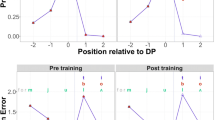Abstract
The likelihood of occurrence of a speech error is influenced by constraints imposed on the word-form generation process as well as by characteristics of the words in the utterance. In three tongue twister experiments I investigated these roles of constraint and opportunity. In Experiments 1 and 2 word onsets were more likely to interact with each other in a speech error than with phonemes in other positions. However, phonemes in word-internal positions were less likely to interact with each other than with word onsets. These results indicate that word onsets are particularly error-prone and therefore often interact with each other, but are also very likely to engage in interactions with phonemes in other positions if the elicitation technique encourages these interactions. The fatal experiment aimed to create speech errors in which consonants and vowels interacted. These errors are rarely reported in the literature but were successfully generated in this experiment. The implications for a model of word-form generation are discussed.
Similar content being viewed by others
REFERENCES
Berg, T. (1991). Phonological processing in a syllable-timed language with prefinal stress: Evidence form Spanish speech error data. Language and Cognitive Processes, 6, 265–301.
Boomer, D. S., & Laver, J. D. M. (1968). Slips of the tongue. British Journal of Disorders of Communication, 3, 2–12.
Brown, A. S. (1991). A review of the tip-of-the-tongue experience. Psychological Bulletin, 109, 204–233.
Brown, R., & McNeil, D. (1966). The “tip of the tongue” phenomenon. Journal of Verbal Learning and Verbal Behavior, 5, 325–337.
Burnage, G. (1990). CELEX: A guide for users. Nijmegen, the Netherlands: SSN.
Dell, G. S. (1986). A spreading activation theory of retrieval in sentence production. Psychological Review, 93, 283–321.
Dell, G. S. (1988). The retrieval of phonological forms in production: Tests of predictions from a connectionist model. Journal of Memory and Language, 27, 124–142.
Dell, G. S., & Reich, P. A. (1981). Stages in sentence production: An analysis of speech error data. Journal of Verbal Learning and Verbal Behavior, 20, 611–629.
del Viso, S., Igoa, J. M., & García-Albea, J. E. (1991). On the autonomy of phonological encoding: Evidence from slips of the tongue in Spanish. Journal of Psycholinguistic Research, 20, 161–185.
Fromkin, V. A. (1971). The non-anomalous nature of anomalous utterances. Language, 47, 27–52.
Fromkin, V. A. (1973). Introduction. In V. A. Fromkin (Ed.), Speech errors as linguistic evidence. The Hague, The Netherlands: Mouton.
García-Albea, J. E., del Viso, S., & Igoa, J. M. (1989). Movement errors and levels of processing in sentence production. Journal of Psycholinguistic Research, 18, 145–161.
Garrett, M. F. (1980a). Levels of processing in sentence production. In B. Butterworth (Ed.), Language production; Vol. 1, Speech and talk (pp. 177–220). London: Academic Press.
Garrett, M. F. (1980b). The limits of accommodation: Arguments for independent processing levels in sentence production. In V. A. Fromkin (Ed.), Errors in linguistic performance: Slips of the tongue, ear, pen, and hand (pp. 263–271). New York: Academic Press.
Jones, H. G. V., & Langford, S. (1987). Phonological blocking in the tip of the tongue state. Cognition, 26, 115–122.
Kempen, G., & Huijbers, P. (1983). The lexicalization process in sentence production and naming: Indirect election of words. Cognition, 14, 185–209.
Levelt, W. J. M. (1989). Speaking: From intention to articulation. Cambridge, MA: MIT Press.
Levelt, W. J. M., & Wheeldon, L. (1994). Do speakers have access to a mental syllabary? Cognition, 50, 239–269.
MacKay, D. G. (1972). The structure of words and syllables: Evidence from errors in speech. Cognitive Psychology, 3, 210–227.
Meijer, P. J. A. (1994). Phonological Encoding: The role of suprasegmental structures. Unpublished doctoral dissertation, Nijmegen University, Nijmegen, The Netherlands.
Meijer, P. J. A. (1996). Suprasegmental structures in phonological encoding: The CV structure. Journal of Memory and Language, 35, 840–853.
Meyer, A. S. (1990). The time course of phonological encoding in language production: The encoding of successive syllables of a word. Journal of Memory and Language, 29, 524–545.
Meyer, A. S., & Schriefers, H. (1991). Phonological facilitation in picture word onset asynchrony and types of interfering stimuli. Journal of Experimental Psychology: Learning, Memory, and Cognition, 17, 1146–1160.
Nooteboom, S. G. (1973). The tongue slips into patterns. In V. A. Fromkin (Ed.), Speech errors as linguistic evidence. The Hague, The Netherlands: Mouton.
Rosenbaum, D. A., Weber, R. J., Hazelett, W. M., & Hindorff, V. (1986). The parameter remapping effect in human performance: Evidence from tongue twisters and finger fumblers. Journal of Memory and Language, 25, 716–726.
Schriefers, H., Meyer, A. S., & Levelt, W. J. M. (1990). Exploring the time-course of lexical access in language production: Picture-word interference studies. Journal of Memory and Language, 29, 86–102.
Shattuck-Hufnagel, S. (1979). Speech errors as evidence for a serial order mechanism in sentence production. In W. E. Cooper and E. C. T. Walker (Eds.), Sentence processing: Psycholinguistic studies presented to Merrill Garrett (pp. 295–342). Hillsdale, NJ: Erlbaum.
Shattuck-Hufnagel, S. (1983). Sublexical units and suprasegmental structure in speech production planning. In P. F. MacNeilage (Ed.), The production of speech (pp. 109–136). New York: Springer.
Shattuck-Hufnagel, S. (1986). The representation of phonological information during speech production planning: evidence from vowel errors in spontaneous speech. Phonology Yearbook, 3, 117–149.
Shattuck-Hufnagel, S. (1987). The role of word onset consonants in speech production planning: New evidence form speech error patterns. In E. Keller & M. Gopnik (Eds.), Motor and sensory processing in language (pp. 17–51). Hillsdale, NJ: Erlbaum.
Shattuck-Hufnagel, S. (1992). The role of word structure in segmental serial ordering. Cognition, 42, 213–259.
Author information
Authors and Affiliations
Rights and permissions
About this article
Cite this article
Meijer, P.J.A. What Speech Errors Can Tell Us About Word-Form Generation: The Roles of Constraint and Opportunity. J Psycholinguist Res 26, 141–158 (1997). https://doi.org/10.1023/A:1025020423225
Issue Date:
DOI: https://doi.org/10.1023/A:1025020423225




